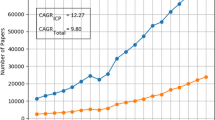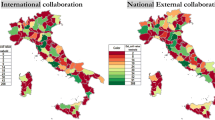Abstract
We propose an indicator to “measure” the extent to which co-publication through international collaboration enhances the value of scientific output of an organisation or agency performing academic research. A second order approach is used which combines a quality proxy (impact) and a quantity or size proxy (number of papers published) to yield a trinity of energy like scalar proxies. From these it is possible to define an index of foreign collaboration and another evenness indicator that shows the size and unevenness of the role foreign collaboration plays in the total academic output of the organization.


Similar content being viewed by others
References
Basu, A., & Aggarwal, R. (2001). International collaboration in science in India and its impact on institutional performance. Scientometrics, 52(3), 379–394.
Chen, C. (2006). CiteSpace II: detecting and visualizing emerging trends and transient patterns in scientific literature. Journal of the American Society for Information Science and Technology, 57(3), 359–377.
Garfield, E. (1955). Citation indexes to science: a new dimension in documentation through association of ideas. Science, 122(3159), 108–111.
Garfield, E. (1999). Journal impact factor: a brief review. Canadian Medical Association Journal, 161(8), 979–980.
Garfield, E. (2005). The agony and the ecstasy: the history and meaning of the journal impact factor. International Congress on Peer Review and Biomedical Publication. http://garfield.library.upenn.edu/papers/jifchicago2005.pdf.
Leydesdorff, L., & Bornmann, L. (2011). Integrated impact indicators (I3) compared with impact factors (IFs): an alternative design with policy implications. Journal of the American Society for Information Science and Technology (in press).
Nishy, P., Panwar, Y., Prasad, S., Mandal, G. K., & Prathap, G. (2012). An impact-citations-exergy (iCX) trajectory analysis of leading research institutions in India. Scientometrics, 91(1), 245–251.
Pendlebury, D. A., & Adams, J. (2012). Comments on a critique of the Thomson Reuters journal impact factor. Scientometrics,. doi:10.1007/s11192-012-0689-6.
Prathap, G. (2011a). A comment to the papers by Opthof and Leydesdorff, Scientometrics, 88, 1011–1016, 2011 and Waltman et al., Scientometrics, 88, 1017–1022, 2011. Scientometrics, 90(2), 737–743.
Prathap, G. (2011b). The Energy–Exergy–Entropy (or EEE) sequences in bibliometric assessment. Scientometrics, 87(3), 515–524.
Prathap, G. (2011c). Energy indicators and percentile ranking normalization. Scientometrics, 91(3), 997–1003.
Vanclay, J. K. (2012). Impact factor: outdated artefact or stepping-stone to journal certification? Scientometrics,. doi:10.1007/s11192-011-0561-0.
Author information
Authors and Affiliations
Corresponding author
Rights and permissions
About this article
Cite this article
Prathap, G. Second order indicators for evaluating international scientific collaboration. Scientometrics 95, 563–570 (2013). https://doi.org/10.1007/s11192-012-0804-8
Received:
Published:
Issue Date:
DOI: https://doi.org/10.1007/s11192-012-0804-8




